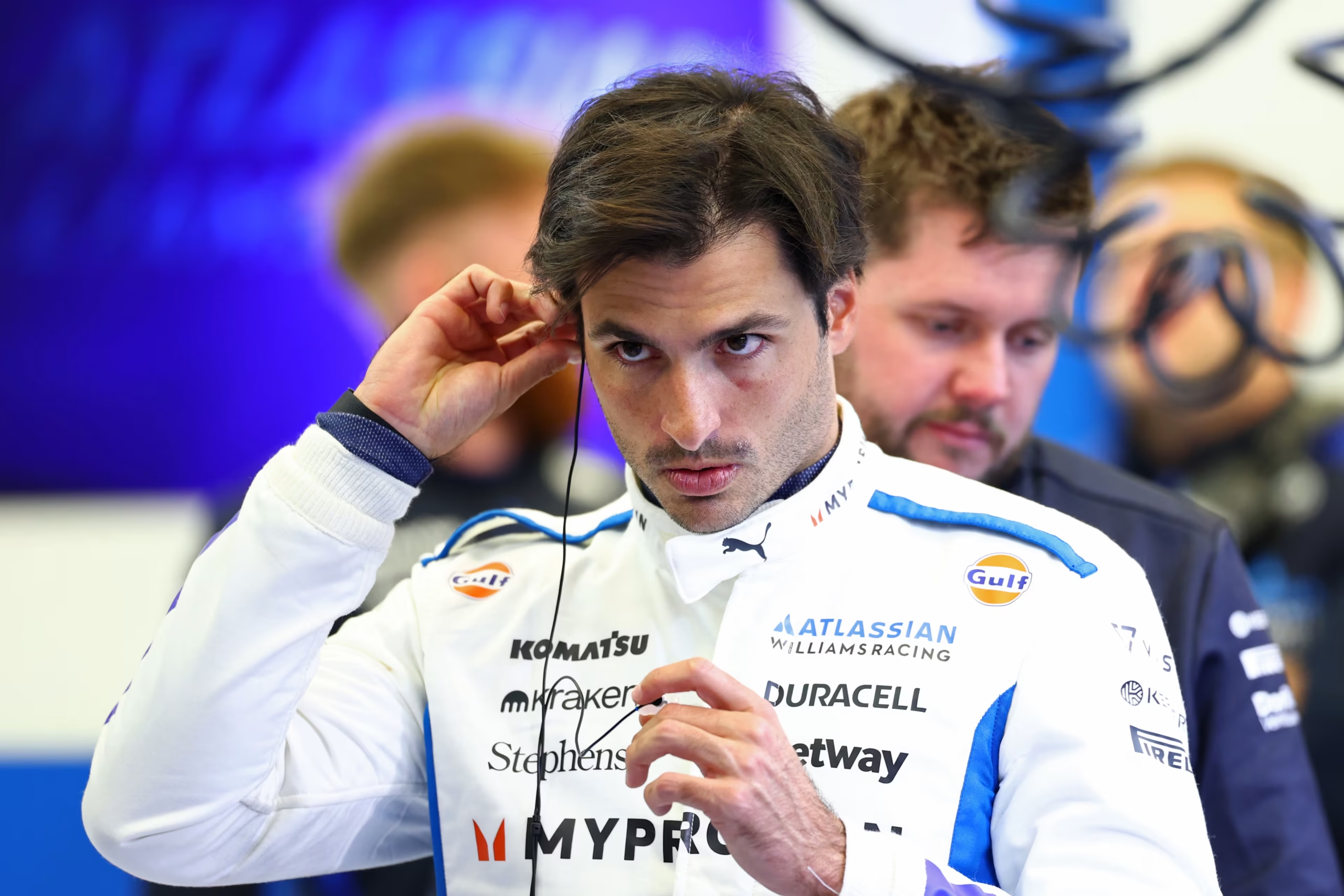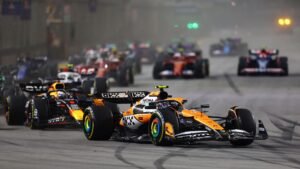Williams Cars Disqualified for Technical Breach at Singapore Grand Prix: What Really Happened
The Formula 1 world was stunned as both Williams Racing cars were disqualified from qualifying for the 2025 Singapore Grand Prix. The FIA found that the rear-wing DRS flaps on both Alex Albon’s and Carlos Sainz’s cars exceeded the legal measurement gap by a few millimetres, a seemingly minor error that carried enormous consequences.
The double disqualification, announced late on Saturday night, not only reshaped the starting grid but also reignited debates about F1’s strict technical compliance standards and how teams manage microscopic tolerances in modern car design.
A Shockwave Through the Paddock
After a competitive qualifying session where both Williams drivers impressed with strong pace around Marina Bay’s street circuit, post-session scrutineering revealed an issue that would devastate the team’s hopes.
FIA Technical Delegate Jo Bauer’s report cited Article 3.10.10 h of the Formula 1 Technical Regulations, which limits the maximum opening of the DRS (Drag Reduction System) flap to 85 mm.
Measurements taken from both Williams cars exceeded this value, triggering an automatic breach of compliance.
“The upper rear-wing element opening exceeded the prescribed limits when DRS was activated. As per Article 3.10.10 h, this constitutes a technical non-compliance,” the FIA statement read.
The result: disqualification from qualifying and a forced start from the back of the grid for both drivers.
What Went Wrong?
Williams issued a prompt statement explaining that the infringement was unintentional and the result of manufacturing and setup tolerances combined with the circuit’s high humidity and temperature.
“We are deeply disappointed by this outcome,” the team said. “Our pre-event checks confirmed that the components were compliant. However, marginal flex or heat expansion under load likely pushed the measurement beyond the limit during FIA testing.”
That tiny deviation, reportedly between 0.2 mm and 0.4 mm, was enough to trigger the harshest possible penalty.
This highlights just how precise F1 engineering has become: a fraction of a millimetre can decide whether a car starts in the top 10 or last.
Understanding the DRS Rule
The DRS (Drag Reduction System) allows drivers to open part of their rear wing on straights to reduce drag and gain top-speed advantage. However, its opening must stay within strict limits for safety and fairness.
- DRS gap limit: 85 mm maximum
- Purpose: Maintain downforce parity and prevent dangerous instability
- Measurement conditions: Static test using calibrated FIA tools after qualifying
Even a minute overextension can be seen as gaining a potential performance benefit, hence the automatic disqualification, regardless of intent or scale.
In Singapore’s high-humidity environment, materials like carbon fibre can slightly expand or flex differently, which may explain how such marginal excess occurred.
A Painful Déjà Vu
This isn’t the first time a team has fallen foul of a DRS-related measurement.
- Lewis Hamilton (Mercedes) suffered disqualification at the 2021 Brazilian GP for a similar violation when his DRS exceeded tolerance by 0.2 mm.
- In 2019, Red Bull Racing had their rear wing cleared only after re-inspection, narrowly avoiding a similar fate.
FIA has long maintained a zero-tolerance policy on such breaches. The reason is simple, even small deviations can yield measurable gains in top-speed performance.
Why the Penalty Is So Severe
Some fans questioned why Williams faced full disqualification instead of a fine or time penalty. The answer lies in F1’s regulatory framework:
- Technical breaches = strict liability.
- If the car does not comply with the Technical Regulations, the driver is excluded, regardless of intent.
Unlike driving infringements, no discretion exists when a car’s physical dimensions violate the rules. FIA stewards consistently apply this principle to maintain fairness.
In their official verdict, the stewards noted:
“The infringement was unintentional; however, compliance with the Technical Regulations is the sole responsibility of the competitor. The car is therefore excluded from the results of qualifying.”
Team Reaction: Calm but Frustrated
Williams Team Principal James Vowles struck a diplomatic tone in post-decision interviews:
“We accept the FIA’s findings and will not appeal. We are, however, conducting a full internal review to understand how the part deviated from specification under real-world conditions.”
The team insisted that performance gains, if any, were negligible, perhaps 0.05 seconds per lap at most. But rules are rules, and the FIA is uncompromising.
Driver Reactions: Disbelief and Determination
Alex Albon:
“We were genuinely quick today. It hurts because we earned that position on merit. The gap was so small, but it’s black-and-white in F1. We’ll fight tomorrow, Singapore isn’t over yet.”
Carlos Sainz:
“The team did everything right, the car felt great. These things happen when tolerances are that tight. I’m just focused on moving forward in the race.”
Both drivers expressed hope that the street circuit’s high attrition rate could still offer chances to climb back through the field.
How the Disqualification Reshaped the Grid
The exclusion had significant implications for the grid and championship picture:
- Oscar Piastri and Lando Norris each moved up one place on the grid.
- Lewis Hamilton and Charles Leclerc gained improved track positions for the start.
- Teams like Alpine and Haas found themselves unexpectedly inside the top 10.
Given how track position is king at Singapore, this reshuffle could dramatically affect race strategy and pit-stop planning.
Engineering Lessons for the Future
Williams’ incident highlights several lessons for teams operating in the precision-critical environment of modern Formula 1:
- Thermal expansion testing:
Components must be tested not only under lab conditions but also in simulated track temperatures (often > 50 °C). - Material flexibility margins:
Carbon composite structures can deform subtly under aerodynamic load. - Measurement redundancy:
Multiple independent calibration checks before scrutineering can reduce error. - Process control:
Race-weekend component checks should be continuous, not just pre-event.
Williams’ engineering team has reportedly already begun introducing new QA and calibration steps for future races.
Fans React: Fair Penalty or Harsh Overreach?
The incident divided the F1 community online.
- Supporters of strict enforcement argue that technical parity is what keeps F1 credible: “If one team gets 0.2 mm leeway, everyone will push that boundary.”
- Others feel the punishment doesn’t fit the crime: “A few microns over spec shouldn’t ruin an entire weekend.”
On social platforms, hashtags such as #WilliamsDQ, #DRSDrama, and #SingaporeShock trended overnight.
Even rival fans admitted sympathy for the Grove-based outfit, noting how heartbreaking it was for a team that’s been on an upward trajectory this season.
FIA’s Perspective: Precision Is the Point
From the FIA’s side, consistency is crucial. The governing body reiterated that its job is not to assess intent but compliance.
Every car goes through post-session checks, including floor plank wear, wing flex, weight distribution, and DRS gap measurement. Random selection ensures no bias.
By treating all violations identically, the FIA aims to prevent loopholes and discourage teams from experimenting near regulatory edges.
Historical Context: Williams’ Road to Recovery
This setback came at a difficult time for Williams. The team had recently shown promising pace, with top-10 finishes in several races.
Since James Vowles’ arrival, Williams has invested heavily in simulation tools, aerodynamic upgrades, and staff expansion. The Singapore result, from strong qualifying to disqualification, was a cruel blow for a team eager to return to consistent points finishes.
Still, the rapid transparency of their response earned respect from fans and competitors alike.
Expert Analysis: Why Small Deviations Matter
Former F1 technical director Gary Anderson explained that even tiny deviations in DRS opening can deliver measurable aerodynamic gains:
“At 200 mph, a 0.3 mm larger gap can reduce drag by around 0.5%, which equates to roughly 0.05 seconds per lap. It’s not huge, but enough to influence qualifying margins.”
Therefore, the FIA’s decision, while strict, aligns with its technical philosophy: every car must meet the letter of the law, not just the spirit.
Implications for the Championship
While Williams isn’t fighting for titles this season, the disqualification has ripple effects:
- Teams like McLaren and Alpine benefit from extra points opportunities.
- Constructors’ standings can swing by millions of dollars in prize money.
- The FIA’s enforcement sends a strong message before the upcoming rounds in Japan and Qatar.
Technical precision has become just as decisive as driver skill.
A Millimetre That Changed Everything
The 2025 Singapore Grand Prix weekend will be remembered not just for sweltering heat and narrow street battles, but for the Williams DRS disqualification, a reminder that in Formula 1, success lives and dies by fractions.
While no one doubts Williams’ integrity or hard work, the FIA’s message is clear: the rules are absolute.
This incident underscores how modern F1 is both an engineering and regulatory war, where a 0.2 mm oversight can erase hours of performance gains and months of development effort.
As Williams regroups for the next race, the team’s response, transparent, accountable, and determined, could prove more valuable than any grid position. They’ll return stronger, smarter, and perhaps even more respected.
















